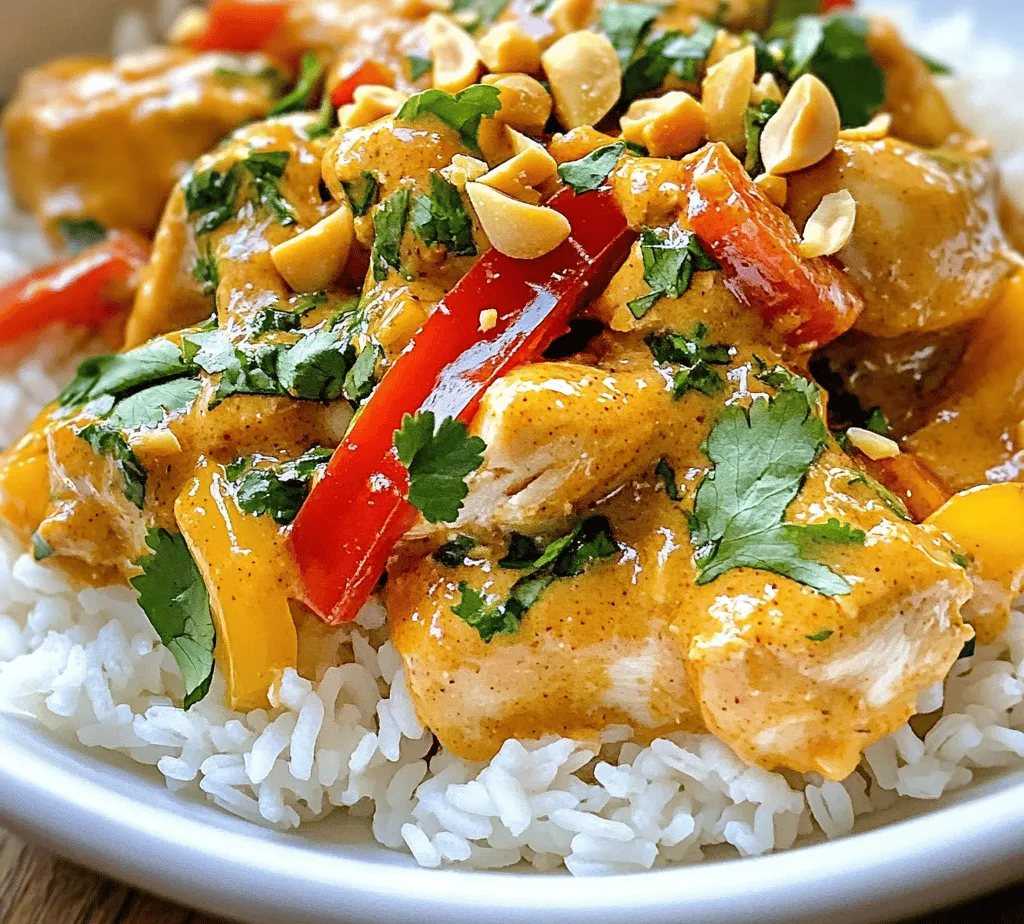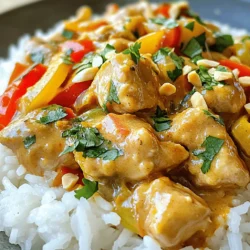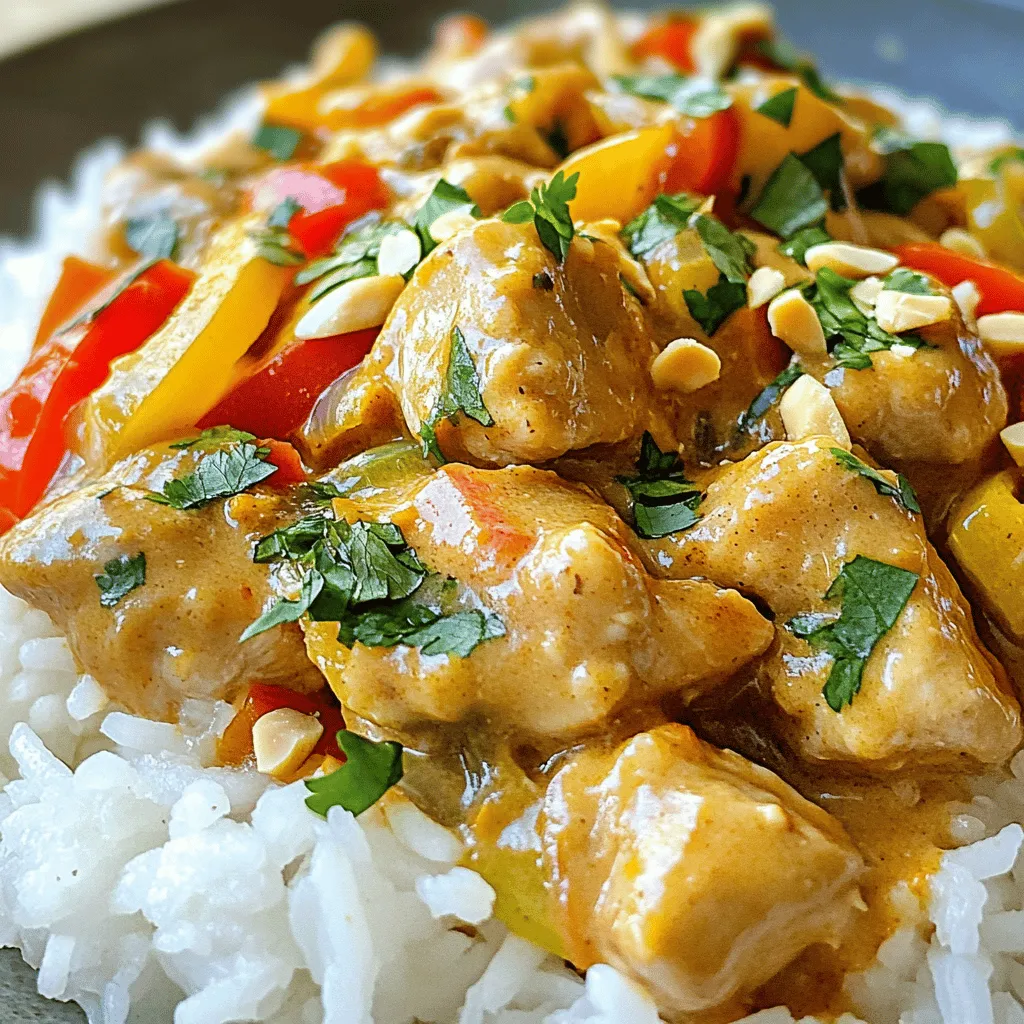Introduction
Thai cuisine is renowned for its vibrant flavors, aromatic ingredients, and the perfect balance of sweet, savory, and spicy elements. From the bustling streets of Bangkok to the elegant dining rooms worldwide, Thai food has captured the hearts—and palates—of many. One dish that stands out among the crowd is Thai Peanut Chicken, a culinary delight that encapsulates the essence of Thai cooking. This dish is not only a feast for the senses but also offers a straightforward preparation process, making it ideal for both weeknight dinners and special occasions.
Thai Peanut Chicken brings together a medley of flavors that appeal to a wide range of tastes. The creamy, nutty sauce made from peanut butter and coconut milk wraps around tender pieces of chicken, creating a satisfying and comforting meal. It’s a perfect example of how Thai cuisine can be both indulgent and wholesome, allowing you to enjoy a restaurant-quality dish right in your home kitchen.
The Allure of Thai Peanut Chicken
Flavor Profile
What makes Thai Peanut Chicken truly enchanting is its exquisite flavor profile. The dish features a rich, creamy sauce crafted from pure peanut butter, aromatic coconut milk, and a blend of spices that elevate the overall taste. The peanut butter lends a nutty sweetness, while the coconut milk adds a luxurious creaminess. When combined with soy sauce, brown sugar, and fresh lime juice, the sauce achieves a perfect harmony of flavors—savory, sweet, and tangy, with just a hint of heat from red pepper flakes. This balance makes every bite a delightful experience.
Versatility
One of the standout features of Thai Peanut Chicken is its versatility. While the classic version typically features chicken as the primary protein, the recipe can easily be adapted to suit various dietary preferences and tastes. Whether you prefer shrimp, tofu, or even a medley of seasonal vegetables, you can customize the dish to fit your needs. Additionally, the peanut sauce pairs beautifully with a variety of grains or noodles, making it easy to create a meal that aligns with your culinary cravings.
Nutritional Benefits
Beyond its captivating taste, Thai Peanut Chicken also boasts a range of nutritional benefits. The choice of boneless, skinless chicken thighs provides lean protein, essential for maintaining a healthy diet. Peanut butter, rich in healthy fats, offers a source of energy while contributing to heart health. Furthermore, the inclusion of colorful vegetables like bell peppers and onions not only enhances the dish’s visual appeal but also adds essential vitamins and minerals. Overall, this dish strikes an excellent balance between indulgence and nutrition, making it a smart choice for any meal.
Ingredients Breakdown
Before we delve into the cooking process, let’s take a closer look at the essential components that come together to create this mouthwatering dish.
Chicken Thighs
For the protein base of this recipe, boneless, skinless chicken thighs are the preferred choice. Unlike chicken breasts, which can become dry when overcooked, chicken thighs are tender and juicy, providing a rich flavor that perfectly complements the creamy peanut sauce. Their ability to absorb flavors makes them an ideal candidate for this dish, ensuring that each bite is packed with deliciousness.
Vegetables
Bell peppers and onions play a crucial role in Thai Peanut Chicken, both in terms of flavor and presentation. The crunchiness of bell peppers adds a refreshing texture that contrasts beautifully with the creamy sauce. Additionally, their vibrant colors—red, yellow, or green—help brighten the dish, making it visually appealing. Onions, when sautéed, contribute a sweet and savory note, enhancing the overall flavor profile.
Aromatics
The depth of flavor in Thai Peanut Chicken also comes from the aromatic duo of garlic and ginger. Both ingredients are staples in Thai cooking, adding layers of complexity to the dish. Garlic imparts a pungent aroma, while ginger offers a touch of warmth and spice. Together, they create a fragrant base that elevates the entire meal, inviting everyone to the table with the promise of something special.
Sauce Components
The heart of Thai Peanut Chicken lies in its signature sauce. Here’s a breakdown of the key ingredients:
– Coconut Milk: This creamy base not only gives the sauce its luscious texture but also adds a subtle sweetness that balances the other flavors.
– Peanut Butter: The star of the show, peanut butter delivers that signature nutty flavor and creaminess. Opt for natural peanut butter for a healthier option, free from additives and sugars.
– Soy Sauce: A splash of soy sauce brings saltiness to the dish, enhancing the overall flavor without overpowering the other ingredients.
– Brown Sugar: To achieve the perfect balance, brown sugar introduces a hint of sweetness that complements the richness of the peanut butter.
– Lime Juice: Fresh lime juice adds a bright, tangy element to the sauce, cutting through the creaminess and providing a refreshing contrast.
– Red Pepper Flakes: For those who enjoy a bit of heat, red pepper flakes can be adjusted to taste, allowing you to customize the spiciness of the dish.
Garnishes
Finally, garnishes play an essential role in elevating the presentation and flavor of Thai Peanut Chicken. A sprinkle of freshly chopped cilantro adds a burst of color and a refreshing herbal note, while crushed peanuts provide crunch and enhance the nutty flavor of the dish. These finishing touches not only make the dish visually appealing but also add layers of flavor that make the dining experience even more enjoyable.
Step-by-Step Cooking Instructions
Now that we’ve explored the delightful components of Thai Peanut Chicken, let’s move on to the cooking process. Here’s a comprehensive guide to preparing this delectable dish.
Cooking the Chicken
1. Preparation: Begin by cutting the boneless, skinless chicken thighs into bite-sized pieces. This will help them cook evenly and absorb the flavors of the sauce. Season the chicken with a pinch of salt and pepper for added flavor.
2. Searing the Chicken: In a large skillet or wok, heat a tablespoon of oil over medium-high heat. Once the oil is hot, add the seasoned chicken pieces to the pan in a single layer, ensuring they have enough space to brown properly. Allow the chicken to cook undisturbed for about 5-7 minutes, until golden brown. Flip the pieces and cook for an additional 3-4 minutes, or until they are cooked through and no longer pink in the center.
3. Removing the Chicken: Once cooked, remove the chicken from the skillet and set it aside on a plate. This step ensures that the chicken remains tender and juicy while you prepare the sauce.
Sautéing the Vegetables
1. Cooking the Aromatics: In the same skillet, add a bit more oil if needed. Lower the heat to medium and add minced garlic and grated ginger. Sauté for about 30 seconds, or until fragrant. Be careful not to let them burn, as this can impart a bitter taste.
2. Adding the Vegetables: Next, toss in sliced bell peppers and onions into the skillet. Stir-fry the vegetables for about 3-5 minutes, until they are tender yet still crisp. The goal is to maintain a bit of crunch, which adds texture to the dish.
3. Combining Ingredients: After the vegetables are cooked to your liking, return the chicken to the skillet. Stir everything together to combine before moving on to the sauce.
With the chicken cooked and vegetables sautéed, you’re well on your way to creating a mouthwatering Thai Peanut Chicken that is sure to impress anyone who tries it. In the next section, we will dive into the creation of the delectable peanut sauce that ties this dish together. Stay tuned for the continuation of this culinary journey!

Crafting the Peanut Sauce
Creating the perfect peanut sauce is the cornerstone of a delicious Thai Peanut Chicken dish. The sauce not only adds flavor but also brings together the other ingredients harmoniously. To achieve an ideal consistency, start by using a combination of creamy peanut butter and coconut milk. The creamy peanut butter provides a rich, nutty flavor, while coconut milk adds a smooth texture and sweetness.
Begin by combining the peanut butter and coconut milk in a mixing bowl. Whisk them together until they form a smooth paste. If you find the sauce too thick, add a splash of warm water or additional coconut milk to reach your desired consistency. The goal is to create a sauce that is thick enough to coat the chicken but smooth enough to drizzle over the dish. For added complexity, consider incorporating soy sauce for saltiness, lime juice for acidity, and a bit of brown sugar for sweetness. Adjust the flavors to your liking, tasting as you go to ensure a perfect balance.
Combining Ingredients
Once your peanut sauce is ready, it’s time to combine it with the chicken. Start by heating a large skillet over medium heat, adding a bit of vegetable oil. Once the oil is hot, add the chicken pieces and sauté until they are golden brown and cooked through, which should take about 5-7 minutes. This step is crucial as it helps develop the flavor of the chicken.
After the chicken is cooked, lower the heat and pour the peanut sauce over the chicken. Allow the mixture to simmer gently for about 5 minutes. Simmering is essential as it helps the chicken absorb the flavors of the sauce, creating a cohesive dish. Stir frequently to ensure the chicken is well-coated and the sauce doesn’t stick to the bottom of the pan. Once the sauce has thickened slightly and the chicken is heated through, your Thai Peanut Chicken is ready to serve.
Serving Suggestions
Thai Peanut Chicken is a versatile dish that can be served in various ways. A classic option is to serve it over a bed of jasmine rice, allowing the fluffy grains to soak up the rich sauce. Alternatively, consider pairing it with rice noodles for a delightful twist. The noodles provide a chewy texture that complements the creamy sauce beautifully.
For a colorful presentation, garnish your dish with freshly chopped cilantro, crushed peanuts, and lime wedges on the side. The cilantro adds a fresh burst of flavor, while the peanuts provide a satisfying crunch. Lime wedges allow diners to add a zesty kick to their servings, enhancing the overall taste experience.
If you’re looking to make it a complete meal, serve the Thai Peanut Chicken alongside sautéed vegetables, such as bell peppers, broccoli, or snap peas. This adds nutrition and color to the plate, making for an appealing presentation.
Cooking Tips for the Perfect Thai Peanut Chicken
Choosing the Right Peanut Butter
The type of peanut butter you select can significantly affect the flavor of your Thai Peanut Chicken. Creamy peanut butter creates a smooth sauce that blends well with other ingredients, making it an excellent choice for this recipe. On the other hand, chunky peanut butter offers a more pronounced texture, adding bits of peanuts for extra crunch. If you prefer a more robust peanut flavor, using a mix of both types can provide an interesting contrast in texture.
Adjusting Spice Levels
Heat is an essential component of Thai cuisine. To adjust the spice level in your Thai Peanut Chicken, consider adding red pepper flakes to the peanut sauce. Start with a small amount (1/4 teaspoon) and gradually increase according to your heat preference. Alternatively, you can use fresh Thai chilies or Sriracha for an extra kick. Remember, the goal is to enhance the dish without overpowering the rich flavors of the peanut sauce.
Vegetarian and Vegan Alternatives
For those looking for vegetarian or vegan options, substituting chicken with tofu or tempeh is an excellent way to enjoy this dish without meat. Firm tofu works best, as it holds its shape during cooking. Press the tofu to remove excess moisture, then cut it into cubes and sauté until golden brown. Tempeh, with its nutty flavor, can also be marinated in the peanut sauce before cooking for added taste. Both alternatives provide a delightful texture and allow everyone to enjoy this flavorful dish.
Meal Prep and Storage
If you have leftovers, storing them correctly is essential to maintain their flavor and texture. Place the Thai Peanut Chicken in an airtight container and store it in the refrigerator for up to three days. When reheating, do so gently on the stovetop or in a microwave, adding a splash of water or coconut milk if the sauce has thickened too much. This will help retain the creamy consistency and prevent the dish from drying out.
Nutritional Information
Understanding the nutritional content of your meals is vital, especially when preparing wholesome dishes like Thai Peanut Chicken. Here’s a breakdown of the estimated nutritional values per serving:
– Caloric Breakdown: A typical serving of Thai Peanut Chicken contains around 400-500 calories, depending on the portion size and ingredients used.
– Macronutrients: Each serving is rich in protein (approximately 25-30 grams), healthy fats (around 20-25 grams from peanut butter and coconut milk), and carbohydrates (approximately 30-40 grams, mostly from rice or noodles).
– Health Benefits: The ingredients in this dish not only provide a satisfying meal but also come packed with health benefits. Peanuts are a great source of protein, healthy fats, and essential vitamins. Chicken provides lean protein, while vegetables add fiber and vitamins, making this dish a nutritious choice.
Cultural Significance of Thai Cuisine
Thai cuisine is renowned worldwide for its bold flavors and vibrant ingredients. It reflects a rich cultural heritage influenced by regional variations that shape cooking styles and flavor profiles.
Regional Variations
In Thailand, each region boasts its unique culinary traditions. For instance, northern Thai cuisine is known for its use of fresh herbs and spices, while southern cuisine often features coconut milk and seafood. The northeastern region, Isaan, is famous for its spicy salads and grilled meats. Thai Peanut Chicken represents a fusion of these influences, showcasing the balance of sweet, salty, sour, and spicy flavors that define Thai cooking.
The Role of Peanuts
Peanuts hold a special place in Thai cuisine and culture. They are not only a beloved snack but also an essential ingredient in many Thai dishes, including sauces, curries, and salads. Historically, peanuts were introduced to Thailand by Chinese immigrants and have since become a staple in Thai cooking. Their creamy texture and rich flavor complement various dishes, making them a favorite in both home kitchens and street food stalls.
Conclusion
Thai Peanut Chicken encapsulates the essence of Thai cuisine, blending rich flavors with fresh ingredients to create a dish that is both satisfying and nutritious. This recipe is easy to prepare and can be customized to suit various dietary preferences, making it an excellent choice for any home cook.
The combination of creamy peanut sauce, tender chicken, and fresh vegetables creates a delightful balance of flavors and textures that everyone will enjoy. Whether served over rice or noodles, this dish is sure to bring the vibrant tastes of Thailand to your dining table.
So, gather your ingredients and give this recipe a try. Experience the joy of cooking and savor the delicious flavors of Thailand in the comfort of your own home. Enjoy a meal that not only nourishes the body but also brings people together, celebrating the rich culinary traditions of Thai cuisine.


